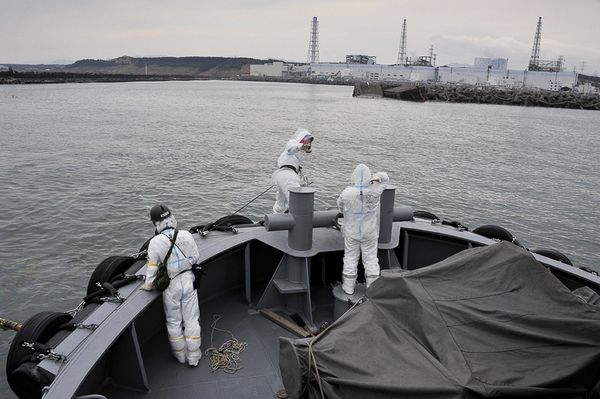Radiation in Japan Seas: Risk of Animal Death, Mutation?

In the past week, seawater samples taken near the nuclear power plant, on Japan’s eastern coast, have shown elevated levels of radioactive isotopes, including cesium 137 and iodine 131. All life on Earth and in the oceans lives with exposure to natural levels of ionizing radiation—high-frequency radiation with enough energy to change DNA. Most such genetic damage heals, but the addition of human-made radiation can make it harder for the body to repair broken genes.
Radiation concentrations in the Japanese seawater samples have fluctuated in past days, but on Wednesday the amount of iodine spiked to 3,355 times the legal limit for seawater according to Japanese nuclear safety officials. That level is the highest so far—and an indication that more radiation is entering the ocean, though how is still unknown, the agency reported. Cesium was also found to be 20 times its safety limit on March 28.
Once in seawater, radiation can hurt ocean animals in several ways—by killing them outright, creating “bizarre mutations” in their offspring, or passing radioactive material up the food chain, according to Joseph Rachlin, director of Lehman College’s Laboratory for Marine and Estuarine Research in New York City.
“There will be a potential for a certain amount of lethality of living organisms, but that’s less of a concern than the possible effects on the genetics of the animals that become exposed,” Rachlin said. “That’s the main problem as I see it with radiation—altering the genetics of the animal and interfering with reproduction.“
To make a “credible assessment” of the risk to marine animals, scientists would have to know the actual concentrations of radioactive iodine in the water and fish or other marine animals off Fukushima Daiichi. It’s possible that levels of radioactive contamination near the Fukushima nuclear reactors could increase and cause some harm to local marine life. If this happens, the most likely effects would be reductions in reproductive potential of local fishes.
Marine organisms’ eggs and larvae are highly sensitive to radiation, since radioactive atoms can replace other atoms in their bodies, resulting in radiation exposure that could alter their DNA. Most such deformed organisms don’t survive, but some can pass abnormalities on to the next generation. Either way, the radiation exposure could hurt the population’s ability to survive long-term.
Rachlin thinks the most susceptible critters would be soft-bodied invertebrates such as jellyfish, sea anemones, and marine worms—which can take up the radiation more quickly than shelled creatures. In addition to its threats to reproduction, pockets of radioactive material can can burn fish passing through, hitting them like a stream of searing water. Complicating matters is the fact that predator species in the Pacific such as tuna and sailfish are already stressed by overfishing.
According to chemical oceanographer Bill Burnett, “In the short run
There could also be some movement of radiation up the food chain if animals eat irradiated plants and smaller, radioactive animals. In particular, plants such as kelp can quickly absorb iodine. There’s a possibility that the devastation of towns in northeastern Japan caused by the earthquake and tsunami also released toxic metals such as lead into the soil and water. Previous studies have shown that metals can work in concert with radiation to suppress immune systems in vertebrates, making them more vulnerable to disease.
The ocean has a “tremendous capacity” for diluting radiation. The best data comes from nuclear weapons tests in the Pacific in the 1950s and 1960s. There’s not much known about radiation in seawater. If the radiation leaks continue for several months, Japan may be dealing with a more serious blow to marine life.(National Geographic)
Worldwide marine radioactivity study (WOMARS)

Commenting rules and guidelines
We value the thoughts and opinions of our readers and welcome healthy discussions on our website. In order to maintain a respectful and positive community, we ask that all commenters follow these rules:
We reserve the right to remove any comments that violate these rules. By commenting on our website, you agree to abide by these guidelines. Thank you for helping to create a positive and welcoming environment for all.